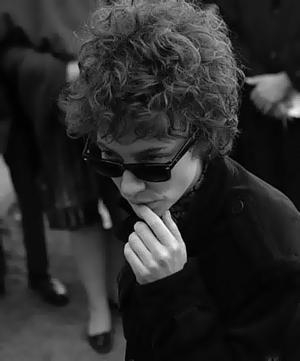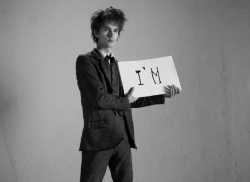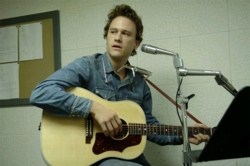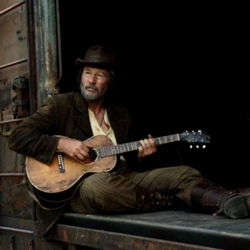 When poet-provocateur Allen Ginsburg pulls up in a golf cart on the side of the highway and asks, “What now?,” Jude – one of six versions of Bob Dylan in Todd Haynes’ film I’m Not There – looks at the sky, his face colored by the desperation and irony that have animated every mask he has worn in a long and unpredictable career. “My salvation?” he half mumbles, both a question and an answer. After they shake hands goodbye, Ginsberg veers off the road toward a cemetery, saying: “Well, we’ll see what we can do.”
When poet-provocateur Allen Ginsburg pulls up in a golf cart on the side of the highway and asks, “What now?,” Jude – one of six versions of Bob Dylan in Todd Haynes’ film I’m Not There – looks at the sky, his face colored by the desperation and irony that have animated every mask he has worn in a long and unpredictable career. “My salvation?” he half mumbles, both a question and an answer. After they shake hands goodbye, Ginsberg veers off the road toward a cemetery, saying: “Well, we’ll see what we can do.”
Like most of Haynes’ film, the first meeting between Bob Dylan and Allen Ginsberg is constructed of a fluid association of anecdotes, lyrics, and wishful thinking, but like any good poetry, it gets closer to the truth than what may or may not have actually happened.
Dylan’s calling towards salvation – what Ginsberg in the golf cart deems both “mission” and “coercion” – is literal, religious, mystical, or otherwise playfully disembodied and transcendent from day-to-day life; and this calling is what flips Dylan’s story forward through a deck of cards of identities including rail riding troubadour (ten year old Marcus Carl Franklin), rebel folkie (Christian Bale), romantic poet (Ben Whishaw), Jude the revolutionary rocker (a masterful Cate Blanchett), megastar family man (Heath Ledger), fundamentalist preacher (Christian Bale, again), and frontier loner (Richard Gere).
 “I bargained for salvation an’ they gave me a lethal dose,” Dylan wails in 1974’s “Shelter from the Storm.” And so it goes for artists with creative vision, arrogance, and stamina as deep as his. From Dante to Shakespeare to William Blake, salvation has always been the ultimate destination: the “what now,” the just around the corner, the just within reach, and the never quite real enough to keep.
“I bargained for salvation an’ they gave me a lethal dose,” Dylan wails in 1974’s “Shelter from the Storm.” And so it goes for artists with creative vision, arrogance, and stamina as deep as his. From Dante to Shakespeare to William Blake, salvation has always been the ultimate destination: the “what now,” the just around the corner, the just within reach, and the never quite real enough to keep.
It has taken Dylan a lot of disguises to stay safe on this trail, and cinematographer Edward Lachman, nominated for an Oscar for his last collaboration with Haynes in 2002’s Far From Heaven, captures long, patient frames and shotgun flashes of Dylan face-to-face with truly lethal doses of salvation, moments when the messiness of life forces the high flyer back to the ground.
Three of these instances stand out: the cocky young singer just arrived in New York, seated sorrowfully before Woody Guthrie dying in hospital bed in 1961; Ledger’s silent despair, sorting family photos after a messy mid-70s divorce; and above all, the tight mask of the ultra hip, self-invented rocker dissolving at the betrayal of a snooty British journalist nemesis who reveals that Jude the legend is in fact a Jewish kid from Brookline, MA named Aaron Jacob Edelstein – the film’s version of Robert Zimmerman of Hibbing, Minnesota.
A Tale of Two Wandering Judes
Dylan’s Jude is not the only star by this name rising on cinema screens this season, as the myths of the sixties – and an endless supply of commercials – continue to evolve through the voices of the song books of the masters of the age.
The lead wanderer of Julie Taymor’s story of 60’s life and the Beatles, Across the Universe, is named Jude as well; part of the conceit of Across the Universe is to give its characters names out of Beatles songs (Jude’s housemates include Prudence, Sadie, and Lucy, and Bono puts in a show-stopping cameo as the hallucinogenic Dr. Robert) so ultimately the entire narrative of the Sixties is told by Beatles songs and enacted by the characters themselves. And just as Dylan/Jude’s marriage unravels with images of the Vietnam War searing television screens in the background in I’m Not There, so too are Taymor’s Jude and his buddies unraveled by bombs in the rice fields of Asia and the streets of New York. It turns out that when it comes to the seemingly eternal music of the golden age of rock and roll royalty (Dylan and the Beatles no doubt sharing the throne above any other pretender to it) beautiful music makes more cultural than historical sense. Yet despite music’s naive claims to transcend history, the world is too messy and life too absurd not to leave a scar.
These are the tales of two very different wandering Judes. Despite the thump, holler, and grit of rhythm and blues amidst a catalogue of perfect melodies, the Beatles were really always all about love. It’s not hard for Taymor to imagine a happy ending in the musical clues she pieces together, creating a simple love story to soften realities’ growl – even when, as here, that growl includes post-traumatic stress disorder, deportation, and alienation. Jude comes home again regardless of history’s claims upon him, escaping the war, capturing the dream, and eventually getting the girl – because “All You Need Is Love.” But for Dylan/Jude as well as all of the other personae in I’m Not There, the lessons of nearly fifty years of recorded music and thousands of live shows cannot help but end precisely where it all began: facing down mortality and corruption while capturing fleeting beauty in choppy frames of recognition and loss.
 Taymor’s film falls flat even as the soundtrack soars because “All You Need Is Love” is simply impossible to believe after what the Sixties as a cultural moment have became – thick with nostalgia and self-congratulation – while Dylan’s story, at least in this version on film, remains raw and troubling despite the pleasure it brings. Both films end on a note of redemptive music – while Gere’s Dylan/Billy loses his home and even his dog, he rediscovers the power of old forms of music and hits the road, much like Dylan in the most recent decade and a half of his career. And both end on a note of indeterminacy too. But there is a nostalgic fondness in Taymor’s film; it loves to look back. Dylan, like the title of Pennebaker’s famous film, always says "Don’t look back."
Taymor’s film falls flat even as the soundtrack soars because “All You Need Is Love” is simply impossible to believe after what the Sixties as a cultural moment have became – thick with nostalgia and self-congratulation – while Dylan’s story, at least in this version on film, remains raw and troubling despite the pleasure it brings. Both films end on a note of redemptive music – while Gere’s Dylan/Billy loses his home and even his dog, he rediscovers the power of old forms of music and hits the road, much like Dylan in the most recent decade and a half of his career. And both end on a note of indeterminacy too. But there is a nostalgic fondness in Taymor’s film; it loves to look back. Dylan, like the title of Pennebaker’s famous film, always says "Don’t look back."
“But I know I Ain’t No Prophet”
As Dylan sings in “Tangled Up in Blue” (just a couple of songs before “Shelter from the Storm)”:
All the people we used to know They’re an illusion to me now. Some are mathematicians Some are carpenter’s wives. Don’t know how it all got started, I don’t know what they’re doin’ with their lives. But me, I’m still on the road Headin’ for another joint We always did feel the same, We just saw it from a different point of view, Tangled up in blue.
The image of the Wandering Jude of Dylan’s oeuvre, unsatisfied with the world as it is and still staying on the road to salvation in spite of it, shares much with another long traveled image of paths of glory, the tireless prophet Elijah.
 Stories of Elijah’s countless masks, rages, and demands are embedded throughout Jewish folkways. Elijah, like the early Dylan, wants to speak truth to power – and like that Dylan, he succeeds too well; the people fall for trickery, choose God for the wrong reasons, and eventually Elijah runs away. In exile, Elijah finds the eternal not in the earthquake or the fire, but in a still, small voice, perhaps, we might even say, one which sings. Then, with the command of God at his back, he covers his face, proclaims his zeal for justice, and, despite the many enemies before him, takes to the road, an outlaw ever since. But just as Dylan says, “To live outside the law you must be honest,” in Jewish tradition Elijah can be found everywhere, in disguise, at the gates of a city in the morning and in the houses of royalty by night; he blesses the poor, unsettles the rich, and continually shuffles the deck of fate with his many faces – like the imagined Dylan of I’m Not There– to keep people honest and humble and locked in real time.
Stories of Elijah’s countless masks, rages, and demands are embedded throughout Jewish folkways. Elijah, like the early Dylan, wants to speak truth to power – and like that Dylan, he succeeds too well; the people fall for trickery, choose God for the wrong reasons, and eventually Elijah runs away. In exile, Elijah finds the eternal not in the earthquake or the fire, but in a still, small voice, perhaps, we might even say, one which sings. Then, with the command of God at his back, he covers his face, proclaims his zeal for justice, and, despite the many enemies before him, takes to the road, an outlaw ever since. But just as Dylan says, “To live outside the law you must be honest,” in Jewish tradition Elijah can be found everywhere, in disguise, at the gates of a city in the morning and in the houses of royalty by night; he blesses the poor, unsettles the rich, and continually shuffles the deck of fate with his many faces – like the imagined Dylan of I’m Not There– to keep people honest and humble and locked in real time.
 Elijah is most famous for the moment he does not arrive at all, his wine glass untouched but for the banging on the Passover table as a child wakes with a start to open the door. The prophet makes no sound, raises no hand, and opens no gates to salvation on the holiday when the Exodus from bondage in Egypt is replayed by all who come to celebrate it. “I’m Not There,” he might say as people seek him with eyes tightly shut, not wanting to know what a lethal dose of salvation might really mean.
Elijah is most famous for the moment he does not arrive at all, his wine glass untouched but for the banging on the Passover table as a child wakes with a start to open the door. The prophet makes no sound, raises no hand, and opens no gates to salvation on the holiday when the Exodus from bondage in Egypt is replayed by all who come to celebrate it. “I’m Not There,” he might say as people seek him with eyes tightly shut, not wanting to know what a lethal dose of salvation might really mean.
Imagine the titles of the three great films on the life and work of Bob Dylan as they might appear in the famous scene of Dylan flashing and dropping cue cards (Allen Ginsberg davening, tongue and cheek, wrapped in a prayer shawl in the background): “Don’t Look Back” – “No Direction Home” – “I’m Not There.” So too goes Haynes’ deep, passionate take on the many lives of Dylan’s seeking: flashes of intimate, gorgeous meaning that stay; and always waiting for just a little bit more.
====
Things Have ChangedJay Michaelson I want to imagine late Dylan not as Richard Gere but as Tommy Lee Jones, the sheriff who’s outlived his time in the latest Coen brothers masterpiece, Dylan’s story resists nostalgia because it has always been a simultaneous denial and embrace of the notion of "roots." The embrace is probably better known: Woody Guthrie, union songs, the blues, the new American music Dylan co-created with the Band, even country music with Johnny Cash and rockabilly in Dylan’s autumn years. But I’m Not There makes more hay out of the denials, the evasions: Dylan’s shifting personae, and an emotional disconnect that begins as naive illusions, evolves into arch diffidence and rock-star obnoxiousness, and finally (as perhaps in Dylan’s own life) settles into an almost psychotic break with reality. There is no there there, as Gertrude Stein said of Oakland — or if there is, we’re not going to get to know it. As such, I’m Not There can only be an oxymoron of a film: a biopic of a man without a bio. Unlike Martin Scorsese’s brilliant No Direction Home – note the same trope of leaving the past, while at the same time being haunted by it – I’m Not There offers no explanations of what made Zimmerman Dylan, or what he really felt or thought, or what other people thought of him. When Stephen Hazan Arnoff shared an early review of the film with an editor from another publication of Jewish interest (he got to the preview; I had to wait to see it upon release) – he was told that the topic was “not Jewish enough.” But of course, I’m Not There is entirely Jewish – denying and embracing the notion of roots. Ironically, Haynes’ "Dylan" invents himself as an African American guitar slinger and an earnest Wobbly folkie, but when it’s revealed that he is, gasp, Jewish, he’s reduced to a cliche: Best Jewish Sports Heroes, and did you know Gene Simmons is Israeli. Because Dylan’s Jewishness is — until Infidels at least – diaspora Jewishness, it is defined by its gaps, by its refusals, and by its dislocations and rootlessness. I’m Not There is a Pentateuch of wandering. Stephen is right to criticize Julie Taymor’s brilliant, psychedelic, and sweeping Across the Universe (recently nominated for a Golden Globe) as nostalgic. But isn’t there something nostalgic about Dylan as well? Sure, it’s not as obvious as Taymor’s flowers and sunshine — though Across the Universeis visually brilliant, and really did, despite my reservations, cause me to feel some imagined excitement of 1966, when horizons were opening, merry pranksters were on the loose, and there was a sense of limitless possibility. (Terence Stamp’s character in The Limey observed that the Sixties really only lasted for about three months in 1966; after that, it was a pop phenomenon only.) But in today’s hyper-capitalist, hyper-postmodern, endlessly Baurillardian world of fakery, even the notion of a wandering Jew/Jude is quaint. Dylan’s last three albums have returned to old forms in order to make timeless music. It’s paid off, artistically and commercially, and I agree with those critics who see the work from the acoustic cover albums (1992’s Good as I Been to You and 1993’s World Gone Wrong) on as representing a period of renewed genius; indeed, it’s arguable that only in the last few years as a carnie showman has Dylan figured Dylan out. But let’s be clear that we, no less than the well-scrubbed hipsters in Taymor’s film, are living in a time of dissolution and destruction, in which the very notion of memory is merging with that of nostalgia, and in which even the earnestness that is so palpable in World Gone Wrong is today tainted with the specter of the simulacrum. This is no country for old men, for the old remember what was, and can look back behind them, if they choose.
|







 It’s easy to forget that when Gere’s Dylan/Billy finally leaves his home and goes back into the world, it’s because his cabin in the woods is about to be bulldozed for a six-lane highway. I don’t know if there’s an analogue to that in Dylan’s own story, but there is in mine: I’m writing this from my own cabin in the woods of upstate New York, yet I know that there is a Wal-Mart only twenty minutes away, and that the Republican "pro-growth" slate swept my town’s elections. Like Tommy Lee Jones in No Country for Old Men, I’m painfully aware that there is precious little country left. For God’s sake, the whole action of that film couldn’t even happen today, since everyone would have a cellphone.
It’s easy to forget that when Gere’s Dylan/Billy finally leaves his home and goes back into the world, it’s because his cabin in the woods is about to be bulldozed for a six-lane highway. I don’t know if there’s an analogue to that in Dylan’s own story, but there is in mine: I’m writing this from my own cabin in the woods of upstate New York, yet I know that there is a Wal-Mart only twenty minutes away, and that the Republican "pro-growth" slate swept my town’s elections. Like Tommy Lee Jones in No Country for Old Men, I’m painfully aware that there is precious little country left. For God’s sake, the whole action of that film couldn’t even happen today, since everyone would have a cellphone.
Hi my family member! I want to say that this post is awesome, great written and include almost all significant infos. I’d like to peer more posts like this .
Not often do I encounter a weblog that is both educated and entertaining, and let me tell you, you may have hit the nail on the head. Your concept is excellent; the issue is something that not sufficient individuals are speaking intelligently about. I am very happy that I stumbled across this in my quest for something relating to this.
This looks absolutely perfect. All these tinny details are made with lot of background knowledge. I like it a lot. This was a useful post and I think it is rather easy to see from the other comments as well that this post is well written and useful.
I appreciate your wordpress template, wherever did you get a hold of it through?
there are many dating services on the internet and i also join some of them”